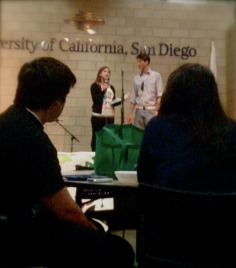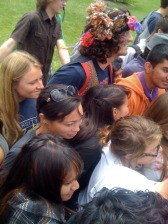"Citizen Artists Making Emphatic Statements" was the name of the exhibit that took place at the 18th Street Art Complex from July to September 2008. This art complex is a community of artists in Santa Monica. The exhibit, curated by Adolpho (Al) Nodal, focused on art that made important statements about issues such as sustainability. A local organization called Fallen Fruit, which focuses on utilizing fruit trees on public land for community use, showed in the exhibit. The organization makes maps of trees on public land so that individuals can find where to pick their own fruit. The organization operates out of Los Angeles and hosts local events, but it has a global perspective. "We kind of look at the whole world through the lens of fruit," said representative Matias Viegener. "That's become our sort of choice focal point, through which we examine a lot of other things." According to the 18th Street website, the center's mission is "to provoke public dialogue through contemporary ART making." Currently there are fifteen artists in residence there, and they often have events for the public to see the art.
 California student leaders gathered last weekend to discuss sustainability at an annual convergence held at the University of California, San Diego.
A group called the California Student Sustainability Coalition (CSSC) hosts both a spring and fall convergence each year at different California university campuses. Student leaders from across California interested in sustainability on campus and in their communities attended these convergences to learn the latest in environmental science and opinions, to share resources, and to socialize with other environmentalists.
 “It’s so great to come together with like-minded people and know you’re not in this struggle alone,” said Orange Coast College student Brianna Flores, who had come to the convergence after being alerted via the CSSC e-mail list. “Sometimes you feel like you’re taking on all these things, and just to come together with all these students who have done so much for their campuses, created such change…it’s really inspiring.”
The mission of the CSSC, according to their website, is “…to unite and empower California’s community of higher education to collaboratively and nonviolently transform our selves and our institutions based on our inherent social, economic, and ecological responsibilities.”
The students were told to arrive Friday night, where they socialized to get to know each other until that night, when many of them sprawled their sleeping bags across the floors of the dorms to sleep. On Saturday, the attendees went to three workshops of their choosing. Workshops, hosted by students, staff, and volunteer speakers, covered a broad range of topics, including traditional foods, how to advertise for a nonprofit organization using the Internet, the effects of meat on the environment, and home composting.
 This semester, UC San Diego’s Student Sustainability Collective hosted the convergence, with convergence coordinator Jared Muscat, an involved member of the student sustainability community.
“It’s kind of our Mecca, you know?” said Muscat. “Every fall and every spring, it’s the one thing we come back to, we see each other if we haven’t seen each other for a while…we get super, super excited, and we just dive right in into all this stuff.”
The convergence provided free vegetarian, organic, local food for all the meals at the convergence, which had been donated by businesses around the campus as well as the campus farming co-op.
Later on Saturday night, there was a concert put on by a local band called The Skavolutionary Orchestra, to which the attendees enthusiastically danced.
Sunday morning, the attendees ate breakfast and attended one more workshop. The last event of the convergence was a spiral hug, in which the attendees all took each others’ hands and spun in a line to create a human spiral, which tightened into a massive group-hug.
Even if the economy wasn't particularly dismal as of late, it's always a good idea to save money. However, the frugal movement has gone largely unnoticed and unapplied, and it seems that many are even ashamed to buy cheaper, second-hand materials, to wear shoes without diamonds on their soles. However, it’s hip to be green, so try these tips, if not for your wallet, then for the planet. These tips are based on the three R’s: Reduce, Reuse, Recycle. By doing these three things, we have to buy less, and less goes to landfills as well. Save green, go green. The Scavenger’s Manifesto by Anneli Rufus and Kristan Lawson different types of scavengers and what they can do. Here are some ways listed in the book that students can utilize:- Bring a re-usable water-bottle. I imagine that the first person to literally sell water for a dollar fifty a bottle must have been trying to prove that they could sell anything to sucker consumers. Try getting water from your sink or a water-fountain.
- Get your books at the library. That’s why it’s there.
- Pick your own fruit and vegetables. Yes, you can pick the fruit on public fruit trees. If it doesn't have a sign stating otherwise, you probably can pick the fruit, so go ahead and find out. I don't know why, but so many people think that fruit that doesn't come from the store is literally poison. You can also use neighborhoodfruit.com to find public trees, and post your own trees.
- Get it second hand. It’s usually cheaper and always better for the environment to get things second-hand, and save it from a landfill. That includes going to garage sales, thrift stores, estate sales, craigslist, and flea-markets.
- Freecycle. That’s right, there is a movement for getting free clothes, books, music, technology, and whatever someone else doesn’t want any more. You can use freecycle.org, the “free” section on craigslist, or just check your parent’s closet for some vintage chic.
- Upcycle. If you don’t like something you have, you can freecycle it or upcycle it. Upcycling is the process of making something you don’t like into something you do. For example, I discovered this T-shirt upcycling community blog, which includes instructions on how to convert your frumpy tees into cute, customized style. Instructables.com also has lots of ideas for upcycling, including the instructions to make a juice carton into a wallet, a comfy chair out of paracords, jewelry out of Monopoly pieces, or a rubik’s cube from an old keyboard. Tell me that’s not cool.
- Dumpster dive. This may seem extreme to many people, but it’s a load of fun to do in a group. The idea is to scavenge through dumpsters to find food, clothing, and technology. Satisfy your inner anarchist and reject capitalism, man. Check out freegan.org.uk for safety, legal, and ethical tips before diving.
- Rideshare. Use craigslist rideshare, zimride, or just carpool with your friends.
There are several ways to save money and live a sustainable life. They key thing to remember is that we don’t need to buy new things all the time. Be innovative and creative, and you’ll save money, help the planet, and have fun doing it.
 There's no diving board involved in dumpster diving, and it's not so theatrical and dangerous as to literally go swimming in garbage. Instead, the Los Angeles Dumpster Diving Meetup Group quickly and carefully sifts through discarded material in commercial dumpsters to "save" landfill-bound goodies.
Last Saturday night in Garfield Park, Pasadena, about a dozen people gathered to take part in this seldom-known art. The group's members are from Meetup.com, a website that connects people with similar interests to other locals. The group went to the dumpsters of Bristol Farms and Trader Joe's to recover apples, bananas, artichokes, iced tea, bagels, banana bread, potatoes...and enough food to fill the back of a flat-bed truck. At the end of the night, the divers took what they wanted from the truck, and the rest was donated to a soup kitchen.
Julianne Lee, a 25-year-old graphic designer, was going dumpster diving for the first time that night. "I want to see if it's true that companies throw away as much as people say they do, to see how wasteful we can be as an American society," said Lee while the group waited for the employees at Trader Joe's to leave.
Although divers scavenge for many things, including technology, clothes, and whatever else they can find in these back-alley treasure chests, this particular diving venture uncovered food. According to a 2004 study at the University of Arizona, Tuscon, the United States throws away nearly half of its food supply.
The group organizers were 45-year-old computer programmer Eric Einem and 21-year-old full-time volunteer Grace.
"For some it's about reducing their consumption...and recovering wasted resources. For others, it's about free food. For others, it's just fun," said Einem of dumpster diving.
This practice is, in addition to being a hobby or necessity, based on community. When Grace moved to LA, she "discovered that LA has, really, no freegan [those who salvage and scavenge goods] community, so I thought, 'well, let's build one!'"
The community has many attractive aspects to it. Those who are anti-establishment and anti-consumerism participate in freeganism because, as no money changes hands, it does not contribute to capitalism. Environmentalists take part because it saves food and goods from going to a landfill as well as minimizes the need for producing more food, which takes energy, water, and land. Humanitarians dumpster-dive to donate food to organizations like Food Not Bombs, which gets much of their food from dumpsters to help the hungry. The food is free, so it is good for frugal people (although oddly, there doesn't appear to be a huge increase with the recession.) Also, the thrill of treasure-hunting at night should enthuse any adventurer. The best adventurers ever, Flapjack and K'nuckles, are into it.
According to Freegan.org.uk, there are many reasons a store would choose to throw away food products. Sometimes it's because the food has gone bad. If this is the case, it's as apparent to the diver as it is to the clerk, and the freegan will toss it away again.
However, the majority of the time food is thrown away because the packaging is damaged, it's near or past its sell-by date (but not its use-by date), one item in a pack is damaged, there is seasonal wrapping, or the store wants to make room for new merchandise.
If you're in the Los Angeles area, you can go to meetup.com/freegan to accompany this group on a diving trip. If you live elsewhere, check the 21 other meetup.com groups created in this growing movement.
|




 RSS Feed
RSS Feed